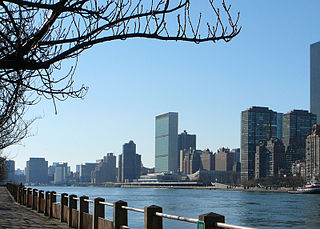
The East River is a saltwater tidal estuary or strait in New York City. The waterway, which is not a river despite its name, connects Upper New York Bay on its south end to Long Island Sound on its north end. It separates Long Island, with the boroughs of Brooklyn and Queens, from Manhattan Island, and from the Bronx on the North American mainland.

Brooklyn is a borough of New York City located at the westernmost end of Long Island in the State of New York. Formerly an independent city, the borough is coextensive with Kings County, one of twelve original counties established under British rule in 1683 in the newly formed Province of New York upon seizing the colony of New Netherland from the Dutch. As of the 2020 United States census, the population stood at 2,736,074, making it the most populous of the five boroughs of New York City, the most populous county in the State of New York, and the ninth most populous county in the United States. In 2022, the population density of Brooklyn was recorded at 37,339.9 inhabitants per square mile (14,417.0/km2), making it the second most densely populated county nationwide, behind only Manhattan. Had Brooklyn remained an independent city, it would today be the fourth most populous American city after New York, Los Angeles, and Chicago.

Long Island City (LIC) is a neighborhood on the western tip of the New York City borough of Queens. It is bordered by Astoria to the north; the East River to the west; Sunnyside to the east; and Newtown Creek, which separates Queens from Greenpoint, Brooklyn, to the south.

Greenpoint is the northernmost neighborhood in the New York City borough of Brooklyn, in the U.S. state of New York. It is bordered on the southwest by Williamsburg at Bushwick Inlet Park and McCarren Park; on the southeast by the Brooklyn–Queens Expressway and East Williamsburg; on the north by Newtown Creek and the neighborhood of Long Island City in Queens; and on the west by the East River. The neighborhood has a large Polish immigrant and Polish-American community, containing many Polish restaurants, markets, and businesses, and it is often referred to as Little Poland.
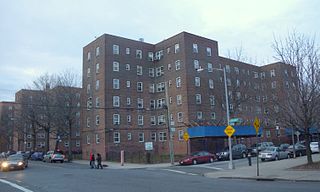
Red Hook is a neighborhood in western Brooklyn, New York City, United States, within the area once known as South Brooklyn. It is located on a peninsula projecting into the Upper New York Bay and is bounded by the Gowanus Expressway and the Carroll Gardens neighborhood on the northeast, Gowanus Canal on the east, and the Upper New York Bay on the west and south. A prosperous shipping and port area in the early 20th century, the area declined in the latter part of the century. Today it is home to the Red Hook Houses, the largest housing project in Brooklyn.

Dumbo is a neighborhood in the New York City borough of Brooklyn. It encompasses two sections: one situated between the Manhattan and Brooklyn Bridges, which connect Brooklyn to Manhattan across the East River, and another extending eastward from the Manhattan Bridge to the Vinegar Hill area. The neighborhood is bounded by Brooklyn Bridge Park to the north, the Brooklyn Bridge to the west, Brooklyn Heights to the south, and Vinegar Hill to the east. Dumbo is part of Brooklyn Community Board 2.

New York City Economic Development Corporation (NYCEDC) is a public-benefit corporation that serves as the official economic development organization for New York City. NYCEDC gives its mission as strengthening business confidence in New York City, diversifying the city's economic sectors, and delivering sustainable infrastructure.

The geography of New York City is characterized by its coastal position at the meeting of the Hudson River and the Atlantic Ocean in a naturally sheltered harbor. The city's geography, with its scarce availability of land, is a contributing factor in making New York the most densely populated major city in the United States. Environmental issues are chiefly concerned with managing this density, which also explains why New York is among the most energy-efficient and least automobile-dependent cities in the United States. The city's climate is temperate.

The Port of New York and New Jersey is the port district of the New York-Newark metropolitan area, encompassing the region within approximately a 25-mile (40 km) radius of the Statue of Liberty National Monument.

The boroughs of New York City are the five major governmental districts that compose New York City. The boroughs are the Bronx, Brooklyn, Manhattan, Queens, and Staten Island. Each borough is coextensive with a respective county of the State of New York: The Bronx is Bronx County, Brooklyn is Kings County, Manhattan is New York County, Queens is Queens County, and Staten Island is Richmond County.

The Manhattan Waterfront Greenway is a waterfront greenway for walking or cycling, 32 miles (51 km) long, around the island of Manhattan, in New York City. The largest portions are operated by the New York City Department of Parks and Recreation. It is separated from motor traffic, and many sections also separate pedestrians from cyclists. There are three principal parts — the East, Harlem and Hudson River Greenways.
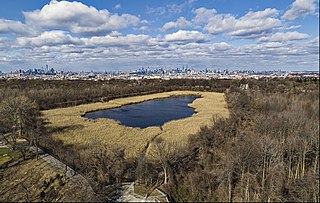
Ridgewood Reservoir is a decommissioned 19th century reservoir and freshwater wetland on the border between the New York City boroughs of Brooklyn and Queens, within what is now Highland Park. Although the reservoir was originally built to secure a reliable water supply for the City of Brooklyn, it is positioned on the Queens side of the border in the neighborhood of Glendale. The reservoir and park are bounded on the north by the Jackie Robinson Parkway, on the south by Highland Boulevard, on the west by Vermont Place and on the east by Cypress Hills National Cemetery.
The Waterfront Alliance or Metropolitan Waterfront Alliance (MWA) is a nonprofit organization that works to influence the development and use of the waterfront, shoreline, and connected upland areas of the Port of New York and New Jersey and the New York–New Jersey Harbor Estuary. It was created as a project by the Municipal Art Society in 1999 and in 2007 it became an independent nonprofit organization.

The East 34th Street Ferry Landing provides slips to ferries and excursion boats in the Port of New York and New Jersey. It is located on the East River in New York City east of the FDR Drive just north of East 34th Street in Midtown Manhattan. The facility, owned by the city, received Federal Highway Administration funding for improvements for docking facilities and upgrading the adjacent East River Greenway in 2008. A new terminal was built and completed in 2012.
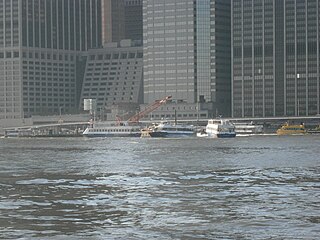
Pier 11/Wall Street is a pier providing slips to ferries and excursion boats on the East River in the Port of New York and New Jersey. It is located east of South Street and FDR Drive just south of Wall Street in Lower Manhattan, New York City. The ferry terminal has five landings, each with two berths, and is used by four privately owned companies.
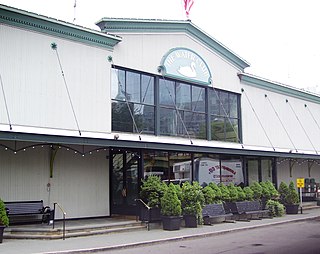
The Water Club was a restaurant and event venue on two barges moored on the East River at East 30th Street in Kips Bay, in Manhattan, New York City. Located on the stretch of waterfront between the East 34th Street Heliport and Waterside Plaza, the venue served classic American cuisine and seafood; it overlooked Long Island City, Queens and Greenpoint, Brooklyn across the river. In the mid-1980s, The Water Club was the tenth largest grossing restaurant in the United States.

The North Brooklyn Community Boathouse (NBCB)] is a Brooklyn-based, volunteer run, 501(c)(3) nonprofit community organization. It is dedicated to enabling safe, responsible, human-powered boating, and educating residents to be stewards of the history, ecology and sustainability of the waterways of Newtown Creek and the adjacent East River.
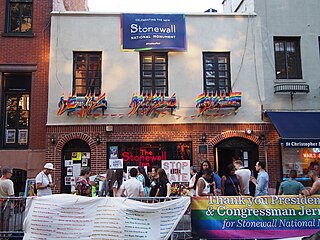
New York City has been described as the gay capital of the world and the central node of the LGBTQ+ sociopolitical ecosystem, and is home to one of the world's largest and most prominent LGBTQ+ populations. Brian Silverman, the author of Frommer's New York City from $90 a Day, wrote the city has "one of the world's largest, loudest, and most powerful LGBT communities", and "Gay and lesbian culture is as much a part of New York's basic identity as yellow cabs, high-rise buildings, and Broadway theatre". LGBT travel guide Queer in the World states, "The fabulosity of Gay New York is unrivaled on Earth, and queer culture seeps into every corner of its five boroughs". LGBT advocate and entertainer Madonna stated metaphorically, "Anyways, not only is New York City the best place in the world because of the queer people here. Let me tell you something, if you can make it here, then you must be queer."
Studio V Architecture, styled as STUDIO V Architecture, founded in 2006, is a New York City-based architecture and planning firm led by Jay Valgora. The firm executes projects across New York and throughout the tri-state region. Studio V has been highlighted for its adaptive reuse design of important New York City sites, including the $400 million renovation of Macy's Herald Square, named by Architectural Record the largest retail project in North America in 2012 and 2013, and the Empire Stores on the Brooklyn waterfront.

The Brooklyn–Queens Connector, abbreviated the BQX, was a proposed streetcar line in New York City. It is planned to operate on a north–south corridor along the East River between the boroughs of Queens and Brooklyn. A previous plan bearing similarities to the BQX was initially proposed in 1989 as part of a Brooklyn waterfront streetcar line connecting Red Hook with Downtown Brooklyn. A study by the city, published in 2011, found the proposal to be infeasible. A later proposal by the nonprofit Friends of the Brooklyn Queens Connector, made public in January 2016, found backing from Mayor Bill de Blasio. A director for Friends of the Brooklyn Queens Connector was appointed in May 2016, and a list of possible routings was released in November 2016.


















